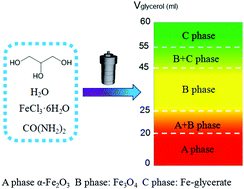Glycerol-assisted tuning of the phase and morphology of iron oxide nanostructures for supercapacitor electrode materials†
Abstract
Iron oxide nanostructures were synthesized via a facile solvothermal method without any template or surfactant in the mixture solvent of water and glycerol. The phase and morphology of the products evolved from an α-Fe2O3 microsphere and α-Fe2O3 button-like particle to Fe3O4 spherical nanoparticle, and then transformed to rod-like Fe-glycerate upon increasing the ratio of glycerol in the solvent. We figured out the roles that glycerol plays in the system as a solvent component at low concentration, reducing agent at medium concentration, and ligand at high concentration. The electrochemical performances of all of these obtained samples were evaluated by employing them as supercapacitor electrodes. The results demonstrated that the ultrafine Fe3O4 nanoparticles possess a high specific capacitance of 426.4 F g−1 at 1 A g−1, which was superior over the button-like α-Fe2O3 (72 F g−1) and Fe-glycerate nanorod (196 F g−1). Such distinguishing supercapacitive performance corresponds to the crystalline phase and inherent size nature of the materials. This study is expected to underline the potential of cost-efficient iron based nanostructures as candidates for supercapacitor electrodes.



 Please wait while we load your content...
Please wait while we load your content...